traction control TOYOTA RAV4 HYBRID 2020 Warranties & Maintenance Guides (in English)
[x] Cancel search | Manufacturer: TOYOTA, Model Year: 2020, Model line: RAV4 HYBRID, Model: TOYOTA RAV4 HYBRID 2020Pages: 260, PDF Size: 8.54 MB
Page 46 of 260
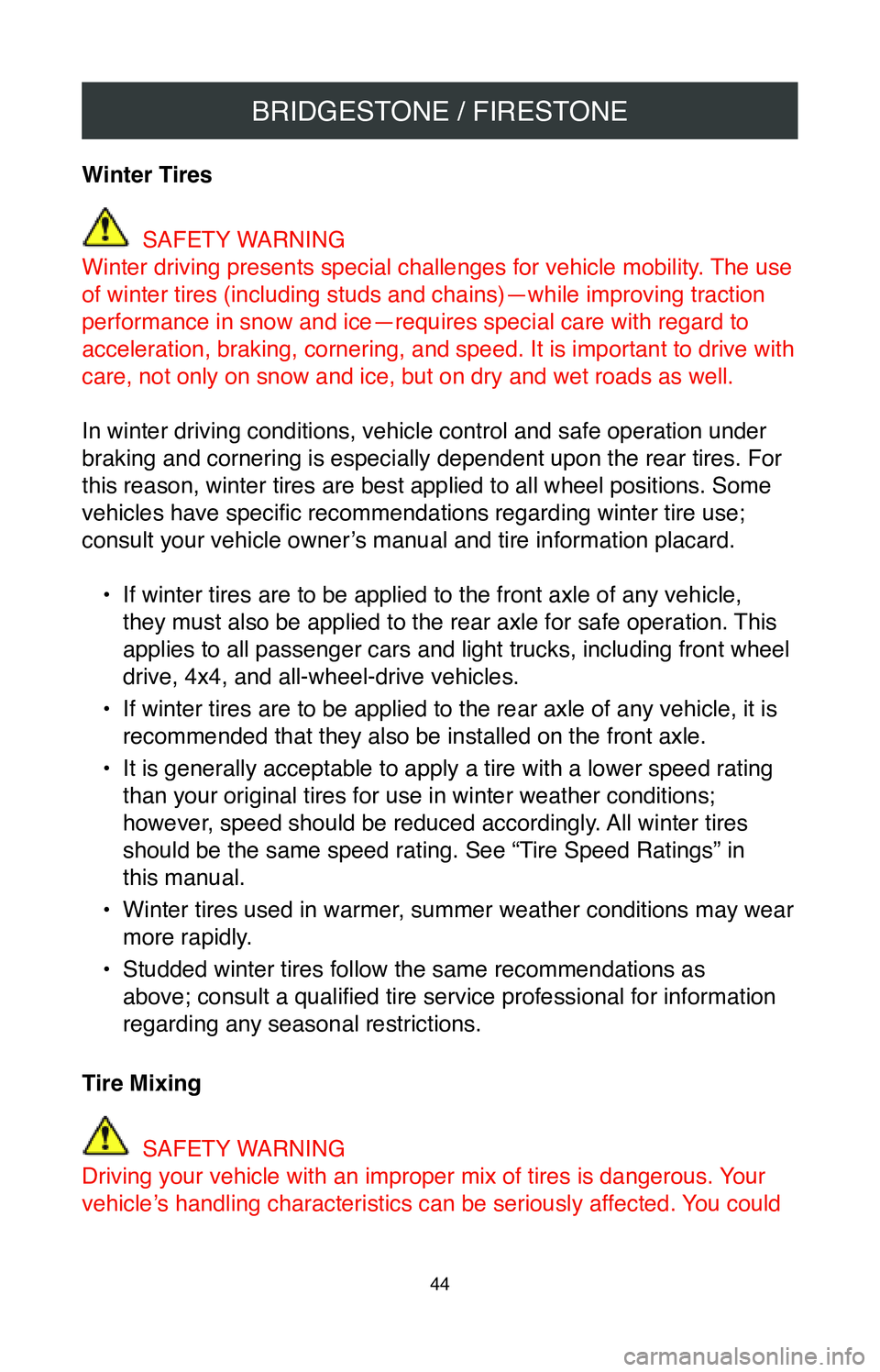
BRIDGESTONE / FIRESTONE
44
Winter Tires
SAFETY WARNING
Winter driving presents special challenges for vehicle mobility. The use
of winter tires (including studs and chains)—while improving traction
performance in snow and ice—requires special care with regard to
acceleration, braking, cornering, and speed. It is important to drive wi\
th
care, not only on snow and ice, but on dry and wet roads as well.
In winter driving conditions, vehicle control and safe operation under
braking and cornering is especially dependent upon the rear tires. For
this reason, winter tires are best applied to all wheel positions. Some \
vehicles have specific recommendations regarding winter tire use;
consult your vehicle owner’s manual and tire information placard.
•
If winter tires are to be applied to the front axle of any vehicle,
they must also be applied to the rear axle for safe operation. This
applies to all passenger cars and light trucks, including front wheel
drive, 4x4, and all-wheel-drive vehicles.
•
If winter tires are to be applied to the rear axle of any vehicle, it is\
recommended that they also be installed on the front axle.
•
It is generally acceptable to apply a tire with a lower speed rating
than your original tires for use in winter weather conditions;
however, speed should be reduced accordingly. All winter tires
should be the same speed rating. See “Tire Speed Ratings” in
this manual.
•
Winter tires used in warmer, summer weather conditions may wear
more rapidly.
•
Studded winter tires follow the same recommendations as
above; consult a qualified tire service professional for information
regarding any seasonal restrictions.
Tire Mixing
SAFETY WARNING
Driving your vehicle with an improper mix of tires is dangerous. Your
vehicle’s handling characteristics can be seriously affected. You could
Page 60 of 260
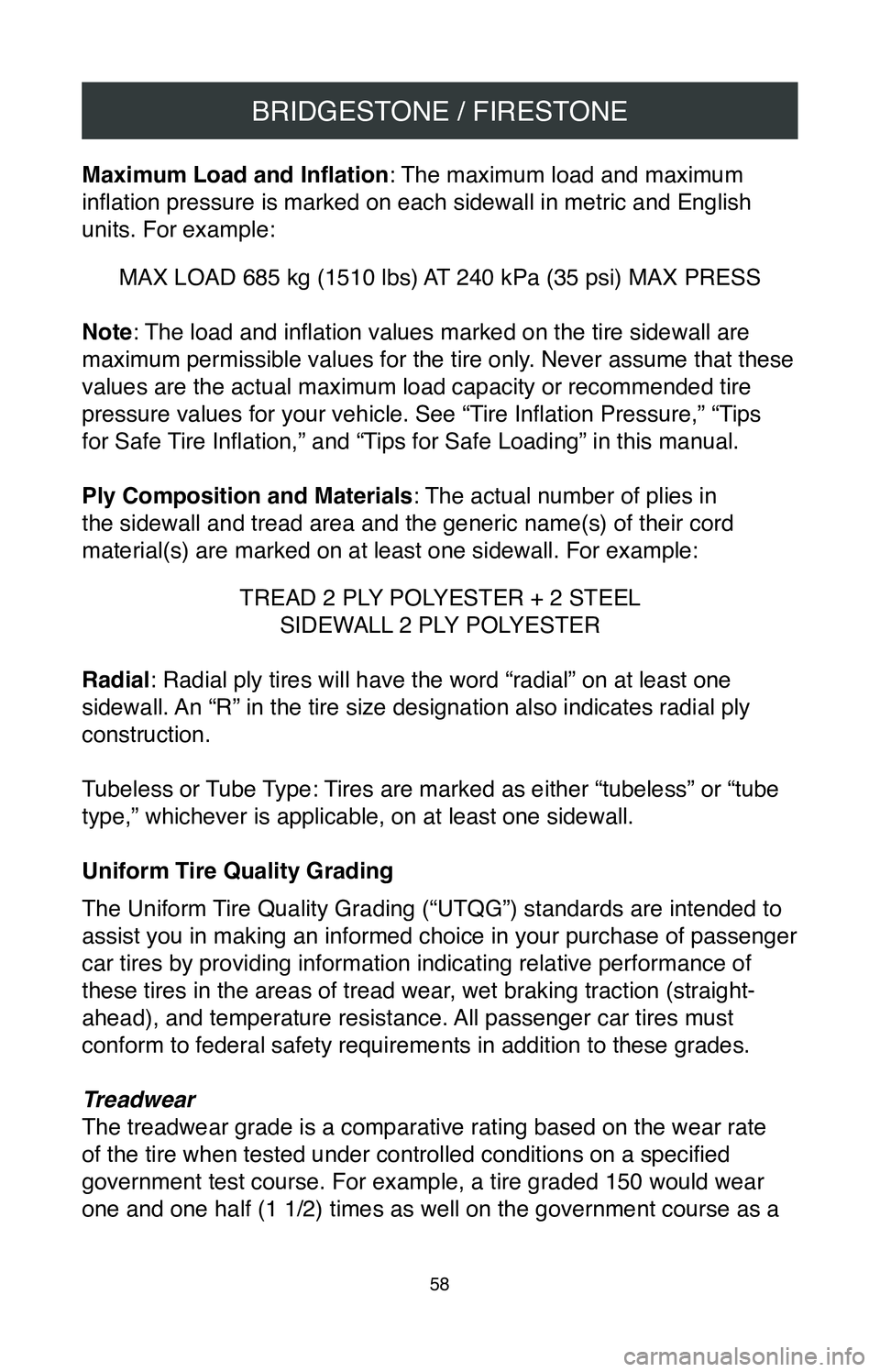
BRIDGESTONE / FIRESTONE
58
Maximum Load and Inflation: The maximum load and maximum
inflation pressure is marked on each sidewall in metric and English
units. For example:
MAX LOAD 685 kg (1510 lbs) AT 240 kPa (35 psi) MAX PRESS
Note: The load and inflation values marked on the tire sidewall are
maximum permissible values for the tire only. Never assume that these
values are the actual maximum load capacity or recommended tire
pressure values for your vehicle. See “Tire Inflation Pressure,” “Tips
for Safe Tire Inflation,” and “Tips for Safe Loading” in this manual.
Ply Composition and Materials : The actual number of plies in
the sidewall and tread area and the generic name(s) of their cord
material(s) are marked on at least one sidewall. For example:
TREAD 2 PLY POLYESTER + 2 STEEL SIDEWALL 2 PLY POLYESTER
Radial: Radial ply tires will have the word “radial” on at least one
sidewall. An “R” in the tire size designation also indicates radial ply
construction.
Tubeless or Tube Type: Tires are marked as either “tubeless” or “tube
type,” whichever is applicable, on at least one sidewall.
Uniform Tire Quality Grading
The Uniform Tire Quality Grading (“UTQG”) standards are intended to
assist you in making an informed choice in your purchase of passenger
car tires by providing information indicating relative performance of
these tires in the areas of tread wear, wet braking traction (straight-
ahead), and temperature resistance. All passenger car tires must
conform to federal safety requirements in addition to these grades.
Treadwear
The treadwear grade is a comparative rating based on the wear rate
of the tire when tested under controlled conditions on a specified
government test course. For example, a tire graded 150 would wear
one and one half (1 1/2) times as well on the government course as a
Page 61 of 260
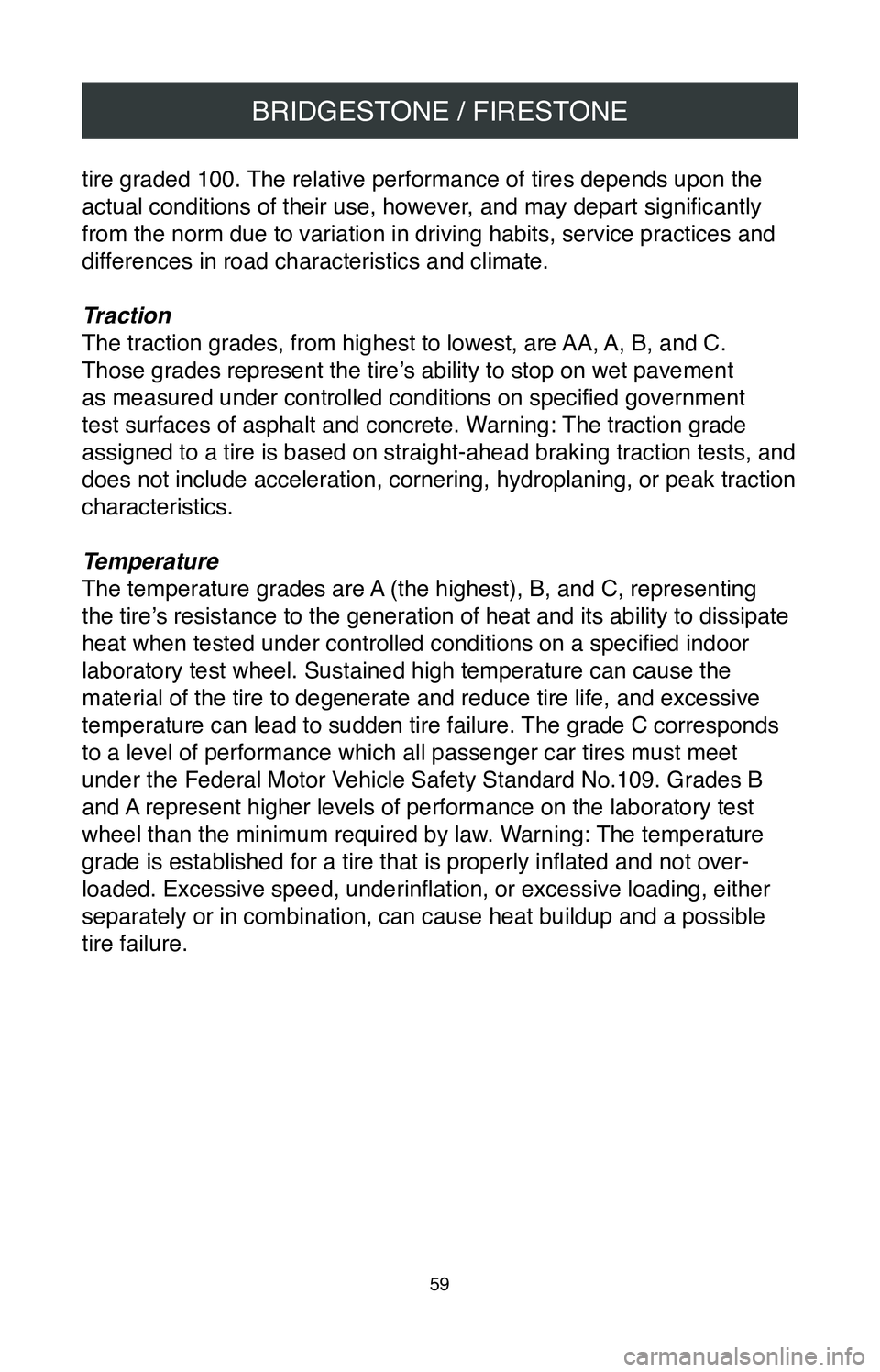
BRIDGESTONE / FIRESTONE
59
tire graded 100. The relative performance of tires depends upon the
actual conditions of their use, however, and may depart significantly
from the norm due to variation in driving habits, service practices and \
differences in road characteristics and climate.
Traction
The traction grades, from highest to lowest, are AA, A, B, and C.
Those grades represent the tire’s ability to stop on wet pavement
as measured under controlled conditions on specified government
test surfaces of asphalt and concrete. Warning: The traction grade
assigned to a tire is based on straight-ahead braking traction tests, and
does not include acceleration, cornering, hydroplaning, or peak traction\
characteristics.
Temperature
The temperature grades are A (the highest), B, and C, representing
the tire’s resistance to the generation of heat and its ability to dissipate
heat when tested under controlled conditions on a specified indoor
laboratory test wheel. Sustained high temperature can cause the
material of the tire to degenerate and reduce tire life, and excessive
temperature can lead to sudden tire failure. The grade C corresponds
to a level of performance which all passenger car tires must meet
under the Federal Motor Vehicle Safety Standard No.109. Grades B
and A represent higher levels of performance on the laboratory test
wheel than the minimum required by law. Warning: The temperature
grade is established for a tire that is properly inflated and not over-
loaded. Excessive speed, underinflation, or excessive loading, either
separately or in combination, can cause heat buildup and a possible
tire failure.
Page 81 of 260

FALKEN
79
like curbs. Your vehicle’s wheels are susceptible to these same
dangers as well. Some vehicles may be originally equipped with high
performance tires that are designed for warmer weather use reducing
traction in colder, winter weather conditions. High performance tires
also pose the possibility of wearing more quickly, giving a stiffer ride,
and producing louder noise than standard all-season tires during
operation. Refer to your vehicle owner’s manual, tire information
placard, or qualified tire service professional for more information about
these kinds of tires.
Winter Tires
Falken recommends all four tires be replaced when replacing your
original equipment tires and installing winter tires for the winter mont\
hs.
SAFETY WARNING
Never use just two winter tires. It could lead to adverse handling, loss
of control, which could cause serious injury or death.
Storing Your Tires
When storing your tires for any extended period of time, be sure to
thoroughly clean your tires with a tire brush, soap, and water to remove\
any dirt, salt, and brake dust from the tires. If you are storing your
tires still mounted on the wheels, use a wheel brush and approved
wheel cleaner to clean your wheels. Then dry the wheels and tires
with a towel and allow them to fully dry. DO NOT apply any tire
dressings while storing your tires. Tire compounds are made to resist
weather cracking and ozone damage. Place each clean and dry tire
in an airtight plastic bag and seal the bag with tape to help reduce oil\
evaporation. Store your tires out of direct sunlight and somewhere that \
is well shielded from the elements, like a climate-controlled room or
dry basement. Storing the tires in a garage or shed usually exposes
the tires to a wide range of temperatures as well as precipitation and
humidity. Keep the tires away from sources that emit ozone like electric
motors that use contact brushes, furnaces, sump pumps, etc. Although
tires will still age regardless of how they are stored, these precaution\
s
will help slow the aging process and reduce the damage to your tires.
Page 88 of 260
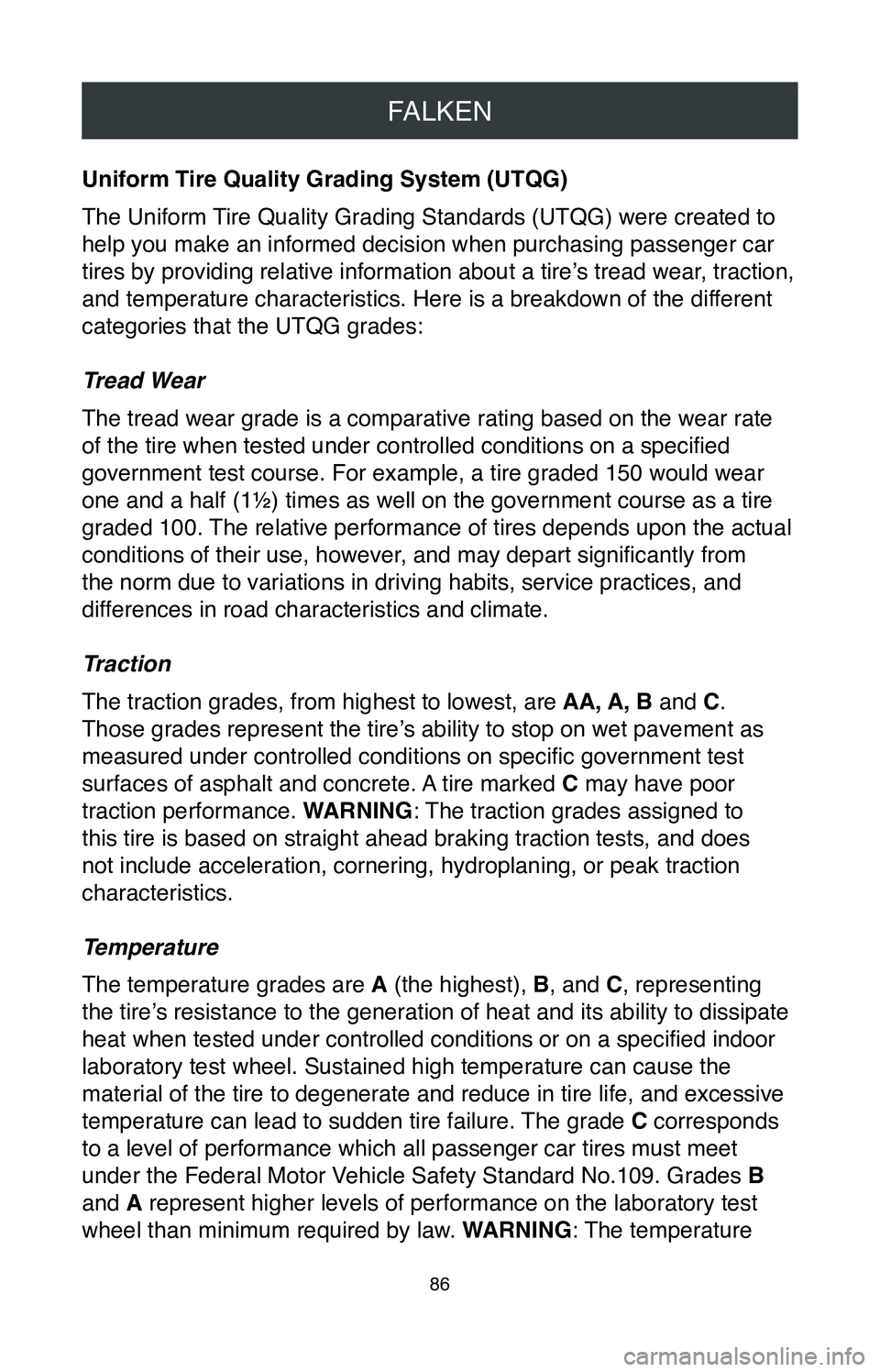
FALKEN
86
Uniform Tire Quality Grading System (UTQG)
The Uniform Tire Quality Grading Standards (UTQG) were created to
help you make an informed decision when purchasing passenger car
tires by providing relative information about a tire’s tread wear, traction,
and temperature characteristics. Here is a breakdown of the different
categories that the UTQG grades:
Tread Wear
The tread wear grade is a comparative rating based on the wear rate
of the tire when tested under controlled conditions on a specified
government test course. For example, a tire graded 150 would wear
one and a half (1½) times as well on the government course as a tire
graded 100. The relative performance of tires depends upon the actual
conditions of their use, however, and may depart significantly from
the norm due to variations in driving habits, service practices, and
differences in road characteristics and climate.
Traction
The traction grades, from highest to lowest, are AA, A, B and C.
Those grades represent the tire’s ability to stop on wet pavement as
measured under controlled conditions on specific government test
surfaces of asphalt and concrete. A tire marked C may have poor
traction performance. WARNING: The traction grades assigned to
this tire is based on straight ahead braking traction tests, and does
not include acceleration, cornering, hydroplaning, or peak traction
characteristics.
Temperature
The temperature grades are A (the highest), B, and C, representing
the tire’s resistance to the generation of heat and its ability to dissipate
heat when tested under controlled conditions or on a specified indoor
laboratory test wheel. Sustained high temperature can cause the
material of the tire to degenerate and reduce in tire life, and excessiv\
e
temperature can lead to sudden tire failure. The grade C corresponds
to a level of performance which all passenger car tires must meet
under the Federal Motor Vehicle Safety Standard No.109. Grades B
and A represent higher levels of performance on the laboratory test
wheel than minimum required by law. WARNING: The temperature
Page 152 of 260
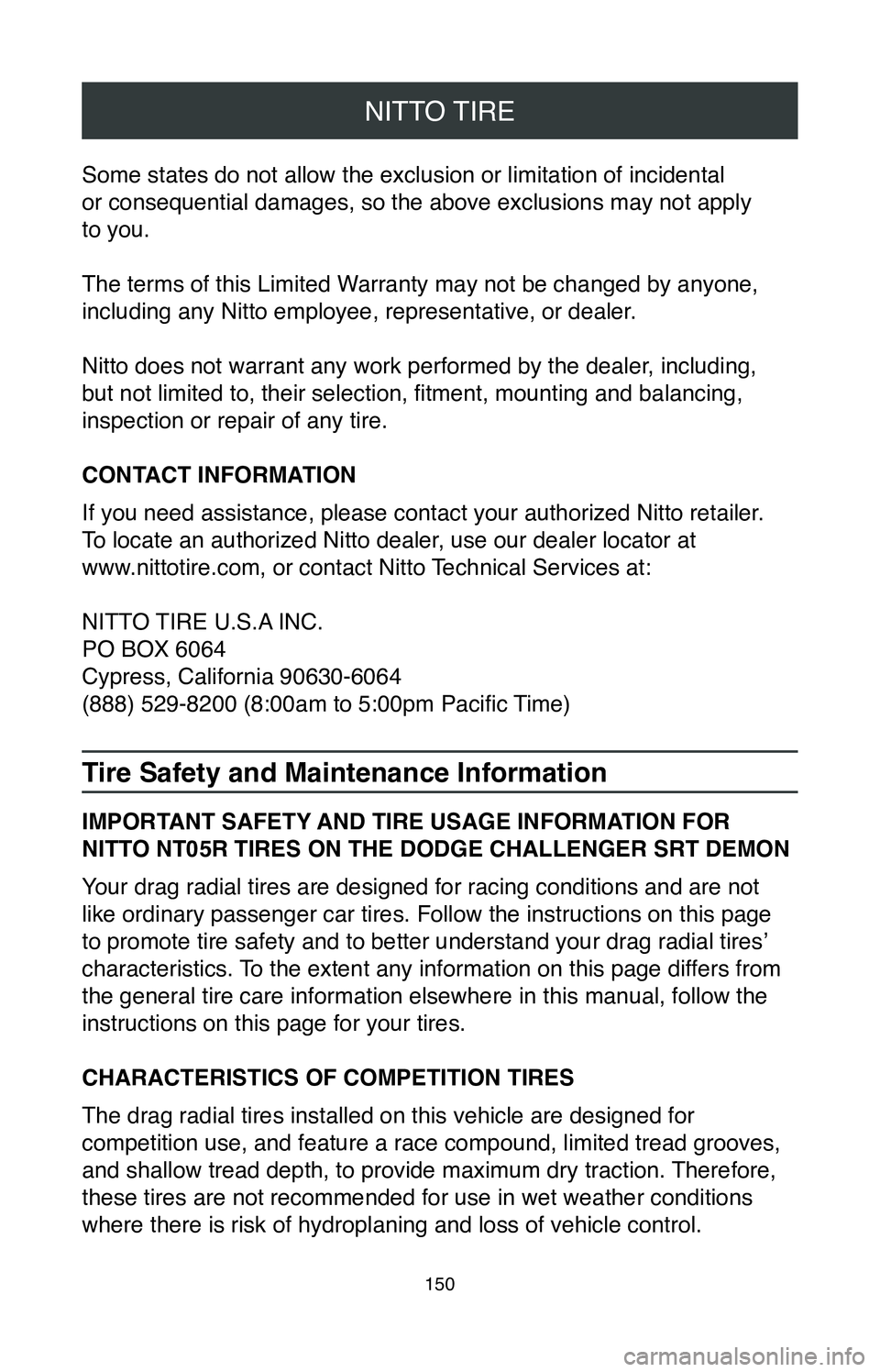
NITTO TIRE
150
Some states do not allow the exclusion or limitation of incidental
or consequential damages, so the above exclusions may not apply
to you.
The terms of this Limited Warranty may not be changed by anyone,
including any Nitto employee, representative, or dealer.
Nitto does not warrant any work performed by the dealer, including,
but not limited to, their selection, fitment, mounting and balancing,
inspection or repair of any tire.
CONTACT INFORMATION
If you need assistance, please contact your authorized Nitto retailer.
To locate an authorized Nitto dealer, use our dealer locator at
www.nittotire.com, or contact Nitto Technical Services at:
NITTO TIRE U.S.A INC.
PO BOX 6064
Cypress, California 90630-6064
(888) 529-8200 (8:00am to 5:00pm Pacific Time)
Tire Safety and Maintenance Information
IMPORTANT SAFETY AND TIRE USAGE INFORMATION FOR
NITTO NT05R TIRES ON THE DODGE CHALLENGER SRT DEMON
Your drag radial tires are designed for racing conditions and are not
like ordinary passenger car tires. Follow the instructions on this page \
to promote tire safety and to better understand your drag radial tires’
characteristics. To the extent any information on this page differs from
the general tire care information elsewhere in this manual, follow the
instructions on this page for your tires.
CHARACTERISTICS OF COMPETITION TIRES
The drag radial tires installed on this vehicle are designed for
competition use, and feature a race compound, limited tread grooves,
and shallow tread depth, to provide maximum dry traction. Therefore,
these tires are not recommended for use in wet weather conditions
where there is risk of hydroplaning and loss of vehicle control.
Page 178 of 260
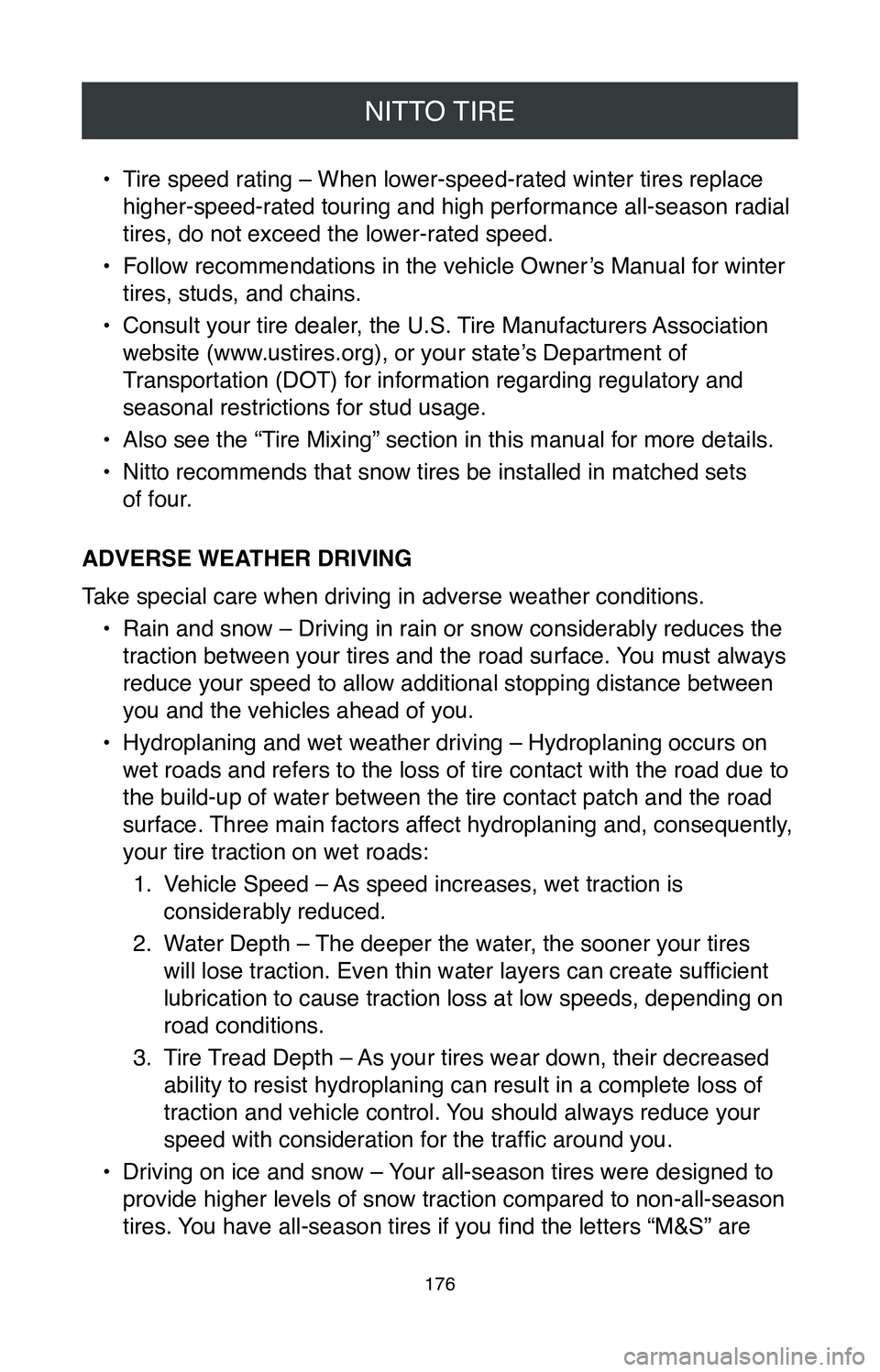
NITTO TIRE
176
• Tire speed rating – When lower-speed-rated winter tires replace
higher-speed-rated touring and high performance all-season radial
tires, do not exceed the lower-rated speed.
•
Follow recommendations in the vehicle Owner’s Manual for winter
tires, studs, and chains.
•
Consult your tire dealer, the U.S. Tire Manufacturers Association
website (www.ustires.org), or your state’s Department of
Transportation (DOT) for information regarding regulatory and
seasonal restrictions for stud usage.
•
Also see the “Tire Mixing” section in this manual for more details.
•
Nitto recommends that snow tires be installed in matched sets
of four.
ADVERSE WEATHER DRIVING
Take special care when driving in adverse weather conditions. •
Rain and snow – Driving in rain or snow considerably reduces the
traction between your tires and the road surface. You must always
reduce your speed to allow additional stopping distance between
you and the vehicles ahead of you.
•
Hydroplaning and wet weather driving – Hydroplaning occurs on
wet roads and refers to the loss of tire contact with the road due to
the build-up of water between the tire contact patch and the road
surface. Three main factors affect hydroplaning and, consequently,
your tire traction on wet roads: 1.
Vehicle Speed – As speed increases, wet traction is
considerably reduced.
2.
Water Depth – The deeper the water, the sooner your tires
will lose traction. Even thin water layers can create sufficient
lubrication to cause traction loss at low speeds, depending on
road conditions.
3.
Tire Tread Depth – As your tires wear down, their decreased
ability to resist hydroplaning can result in a complete loss of
traction and vehicle control. You should always reduce your
speed with consideration for the traffic around you.
•
Driving on ice and snow – Your all-season tires were designed to
provide higher levels of snow traction compared to non-all-season
tires. You have all-season tires if you find the letters “M&S” are
Page 186 of 260
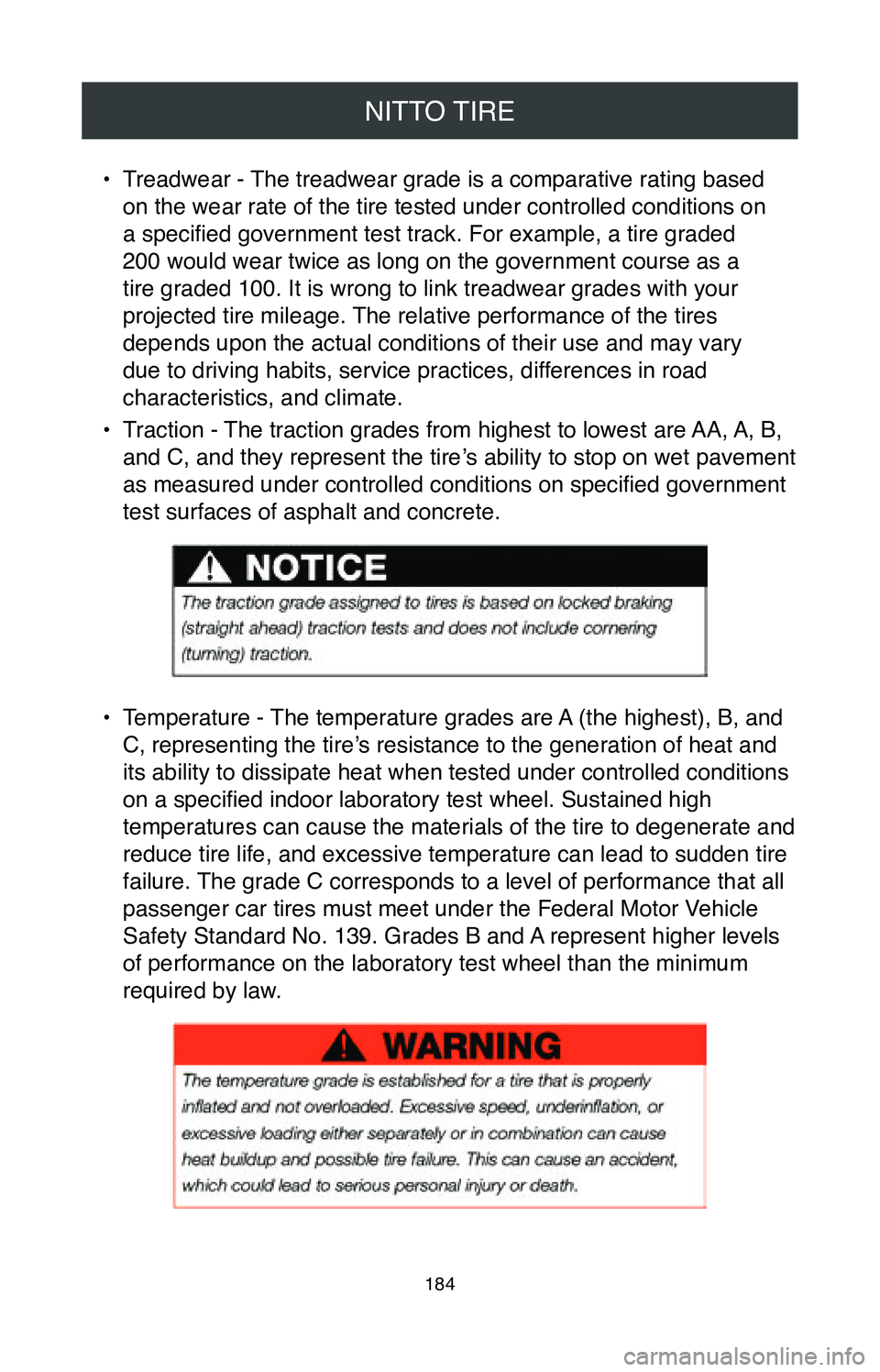
NITTO TIRE
184
• Treadwear - The treadwear grade is a comparative rating based
on the wear rate of the tire tested under controlled conditions on
a specified government test track. For example, a tire graded
200 would wear twice as long on the government course as a
tire graded 100. It is wrong to link treadwear grades with your
projected tire mileage. The relative performance of the tires
depends upon the actual conditions of their use and may vary
due to driving habits, service practices, differences in road
characteristics, and climate.
•
Traction - The traction grades from highest to lowest are AA, A, B,
and C, and they represent the tire’s ability to stop on wet pavement
as measured under controlled conditions on specified government
test surfaces of asphalt and concrete.
• Temperature - The temperature grades are A (the highest), B, and
C, representing the tire’s resistance to the generation of heat and
its ability to dissipate heat when tested under controlled conditions
on a specified indoor laboratory test wheel. Sustained high
temperatures can cause the materials of the tire to degenerate and
reduce tire life, and excessive temperature can lead to sudden tire
failure. The grade C corresponds to a level of performance that all
passenger car tires must meet under the Federal Motor Vehicle
Safety Standard No. 139. Grades B and A represent higher levels
of performance on the laboratory test wheel than the minimum
required by law.
Page 237 of 260
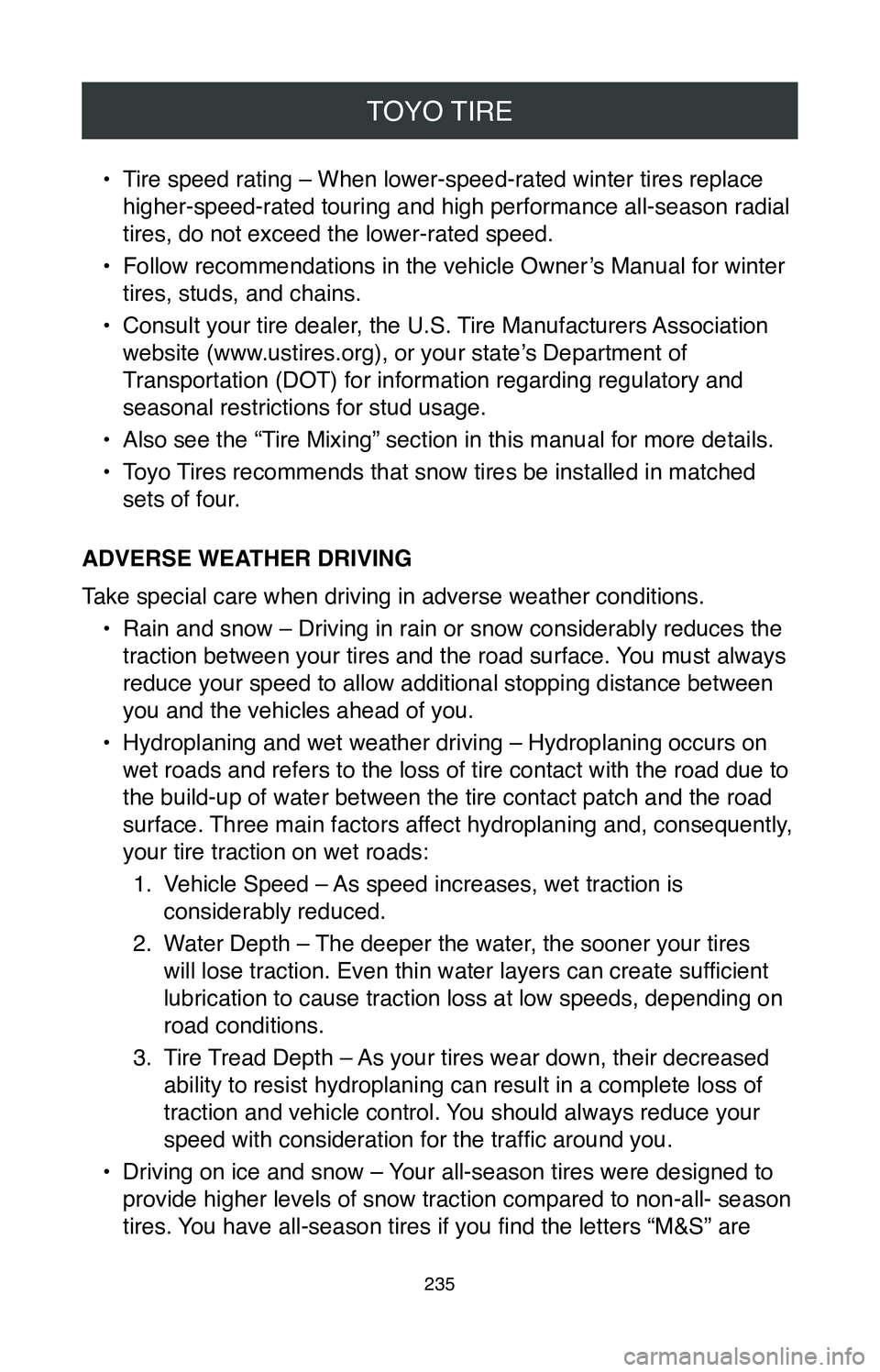
TOYO TIRE
235
• Tire speed rating – When lower-speed-rated winter tires replace
higher-speed-rated touring and high performance all-season radial
tires, do not exceed the lower-rated speed.
•
Follow recommendations in the vehicle Owner’s Manual for winter
tires, studs, and chains.
•
Consult your tire dealer, the U.S. Tire Manufacturers Association
website (www.ustires.org), or your state’s Department of
Transportation (DOT) for information regarding regulatory and
seasonal restrictions for stud usage.
•
Also see the “Tire Mixing” section in this manual for more details.
•
Toyo Tires recommends that snow tires be installed in matched
sets of four.
ADVERSE WEATHER DRIVING
Take special care when driving in adverse weather conditions. •
Rain and snow – Driving in rain or snow considerably reduces the
traction between your tires and the road surface. You must always
reduce your speed to allow additional stopping distance between
you and the vehicles ahead of you.
•
Hydroplaning and wet weather driving – Hydroplaning occurs on
wet roads and refers to the loss of tire contact with the road due to
the build-up of water between the tire contact patch and the road
surface. Three main factors affect hydroplaning and, consequently,
your tire traction on wet roads: 1.
Vehicle Speed – As speed increases, wet traction is
considerably reduced.
2.
Water Depth – The deeper the water, the sooner your tires
will lose traction. Even thin water layers can create sufficient
lubrication to cause traction loss at low speeds, depending on
road conditions.
3.
Tire Tread Depth – As your tires wear down, their decreased
ability to resist hydroplaning can result in a complete loss of
traction and vehicle control. You should always reduce your
speed with consideration for the traffic around you.
•
Driving on ice and snow – Your all-season tires were designed to
provide higher levels of snow traction compared to non-all- season
tires. You have all-season tires if you find the letters “M&S” are
Page 245 of 260
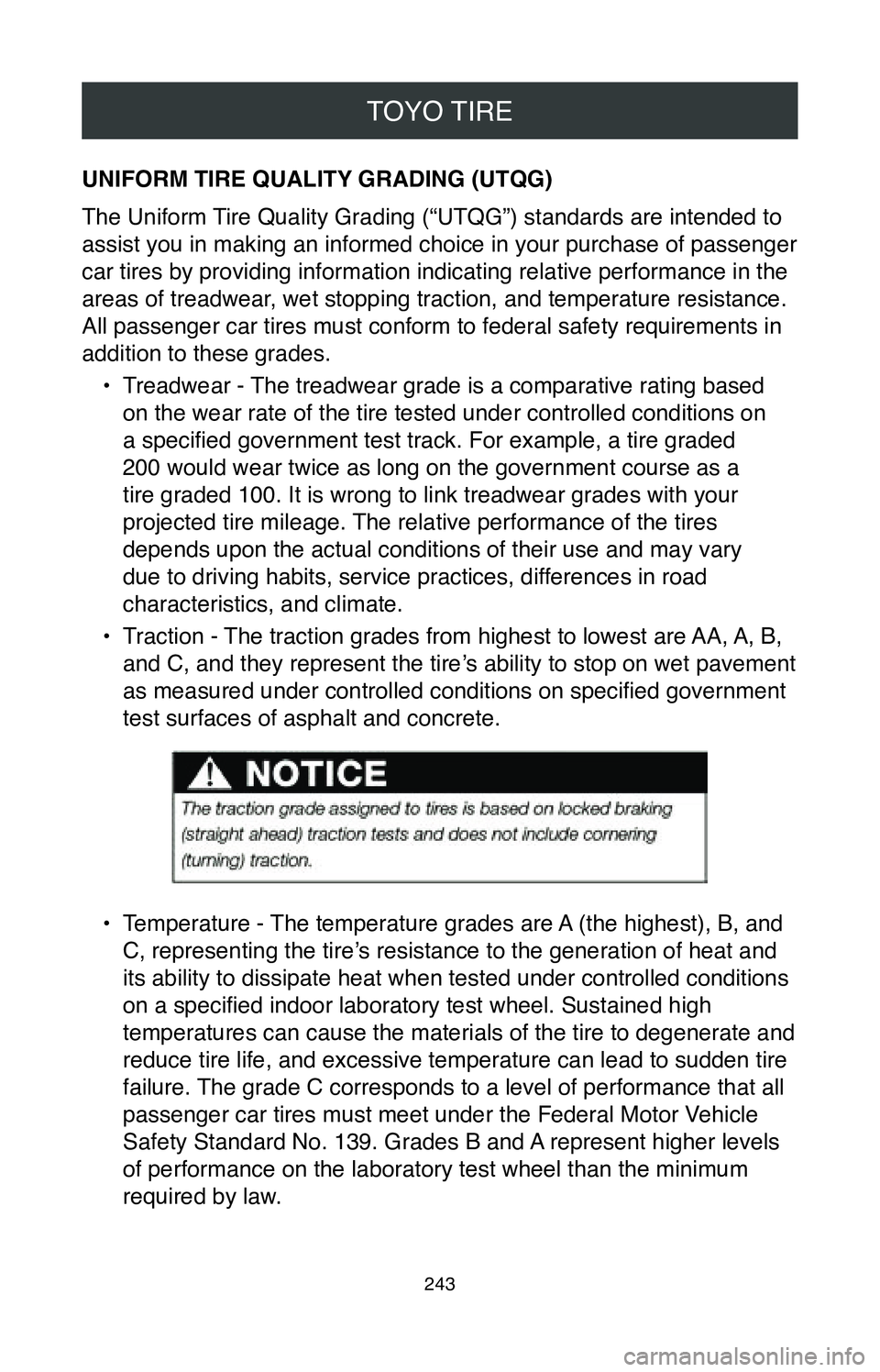
TOYO TIRE
243
UNIFORM TIRE QUALITY GRADING (UTQG)
The Uniform Tire Quality Grading (“UTQG”) standards are intended to
assist you in making an informed choice in your purchase of passenger
car tires by providing information indicating relative performance in th\
e
areas of treadwear, wet stopping traction, and temperature resistance.
All passenger car tires must conform to federal safety requirements in
addition to these grades.•
Treadwear - The treadwear grade is a comparative rating based
on the wear rate of the tire tested under controlled conditions on
a specified government test track. For example, a tire graded
200 would wear twice as long on the government course as a
tire graded 100. It is wrong to link treadwear grades with your
projected tire mileage. The relative performance of the tires
depends upon the actual conditions of their use and may vary
due to driving habits, service practices, differences in road
characteristics, and climate.
•
Traction - The traction grades from highest to lowest are AA, A, B,
and C, and they represent the tire’s ability to stop on wet pavement
as measured under controlled conditions on specified government
test surfaces of asphalt and concrete.
• Temperature - The temperature grades are A (the highest), B, and
C, representing the tire’s resistance to the generation of heat and
its ability to dissipate heat when tested under controlled conditions
on a specified indoor laboratory test wheel. Sustained high
temperatures can cause the materials of the tire to degenerate and
reduce tire life, and excessive temperature can lead to sudden tire
failure. The grade C corresponds to a level of performance that all
passenger car tires must meet under the Federal Motor Vehicle
Safety Standard No. 139. Grades B and A represent higher levels
of performance on the laboratory test wheel than the minimum
required by law.